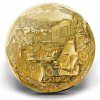 Have you ever wondered if the Olympic medals are actually made of gold at all? It turns out today’s gold medals actually contain very little gold at all.
Have you ever wondered if the Olympic medals are actually made of gold at all? It turns out today’s gold medals actually contain very little gold at all.
The comments above and below are excerpts from an article by Peter Schiff (SchiffGold.com) which has been edited ([ ]) and abridged (…) to provide a faster and easier read.
Gold Medal History
During the Ancient Olympic Games, winners didn’t receive medals at all. Instead, they won a wreath made from olive leaves from a sacred tree near the temple of Zeus at Olympia. It wasn’t until the 1896 Summer Olympics that winners were awarded with actual hardware. However, at that time top performers didn’t win gold; they took home silver. Second place received bronze.
It wasn’t until the 1904 Games in St. Louis that athletes were awarded gold medals for first place, moving silver and bronze to their respective places. Although the gold medals at the time were smaller, they were also completely made of the yellow metal, but with WWI’s approach, the use of solid gold medals quickly diminished. According to Wikipedia, the last series of Olympic medals to be made of solid gold were “awarded at the 1912 Olympic Games in Stockholm, Sweden.”
Olympic Medal Design and Size
Throughout much of their history, the design and size of Olympic medals has remained relative stable. From 1928 through 1968 the design was always the same: the obverse showed the Greek goddess Nike with Rome’s Colosseum in the background and text naming the host city; the reverse showed another generic design of Nike saluting an Olympic champion.
As a standard, all Olympic “gold” medals must be made from at least 92.5% silver, and must contain a minimum of 6 grams of gold. All medals must be at least 60mm in diameter and 3mm thick. Their size has changed from one game to another. The 2008 Beijing Olympics medals are much larger, having a diameter of 70mm and thickness of 6mm.
2016 Rio Olympic Medals
So how are the gold medals for the 2016 Olympic Games in Rio created? According to USA Today, the 500 gram “gold” medals consist of mostly silver, which is plated with “a tiny amount of Brazilian gold.” A solid gold medal would be too cost-prohibitive. To put that into perspective, to produce a single pure gold 2016 Olympic medal would cost around $23,500. However, with the silver center, the Mint was able to cut that cost to around $600 per medal.
In 2012 the top 3 countries won 1,650 gold medals. If we use that same medal count for the Rio games, pure gold medals would cost $38,777,000 just to adorn the first place Olympians!…
While the gold used for plating meets purity standards set by the Olympic council, the silver and bronze medals are made from recycled materials. It’s all part of a “green” sustainability initiative, which set a goal of using 30% recycled materials. According to Rio 2016:
“Half of the plastic in the ribbons, which will be used to hang the medals around athletes’ necks, comes from recycled plastic bottles. The rounded cases that hold the medals were made from freijó wood certified by the Forest Stewardship Council.”
The Brazilian Mint is responsible for delivering the medals when needed along with keeping them safe within their vaults.
The fact that the world can’t afford to create pure gold medals for its top athletes speaks volumes about the current value of gold and silver. Use the Rio Olympic Games to inspire you to begin looking into buying gold and silver yourself.
 munKNEE.com Your Key to Making Money
munKNEE.com Your Key to Making Money